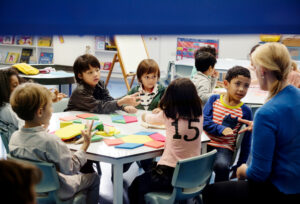Introduction: Why School Safety is Important
School is a place for learning, creativity, and friendship, but it should also be a safe environment where children feel secure and protected. While teachers and staff work hard to ensure students’ safety, it’s just as important for children to understand and follow essential safety rules at school.
Many of the top international schools in Bangalore focus not only on academic excellence but also on creating a safe and supportive environment for every child. From knowing how to react in an emergency to practicing good hygiene, these rules are designed to prevent accidents and create a safe, respectful learning environment. Whether it’s in the classroom, playground, or school bus, following these rules will help students stay alert, responsible, and confident.
Let’s explore the 10 most important safety rules every child should follow at school.
10 Must-Know Safety Rules at School
1. Always Listen to Teachers and School Staff
Teachers and school staff are there to guide and protect students. Listening to their instructions — whether during class, fire drills, or emergencies — is the first step to staying safe.
Safety also goes beyond the classroom. Students should follow essential road safety measures like using pedestrian crossings, following traffic rules, and being careful near school buses. Staying alert and following directions helps create a safe environment both in school and on the way home.
2. Walk, Don’t Run – Especially in Hallways
Running in school hallways, staircases, or crowded areas can be dangerous. Slips, falls, and collisions can lead to injuries for both the runner and others around them. Instead, students should always walk calmly, paying attention to their surroundings.
This rule also applies to getting on and off the school bus. Running near a moving bus or crossing the road carelessly can be extremely risky.
3. Keep Hands and Feet to Yourself
Respect for personal space is a key part of school safety. Pushing, shoving, or rough play can lead to accidental injuries, even if it’s not intentional. Keeping hands, feet, and objects to oneself helps create a respectful and safe learning environment.
If a student feels frustrated or upset, they should talk to a teacher or counselor rather than expressing emotions through physical actions.
4. Know and Follow Emergency Procedures
Every school has safety drills for fires, earthquakes, or lockdown situations. Students should know where to go, how to stay calm, and who to follow during these emergencies.
Some key emergency procedures include:
- Lining up quickly and quietly when the alarm sounds.
- Knowing the nearest exit and assembly points.
- Avoiding running or panicking in an emergency.
Regular practice helps students react confidently and safely if a real emergency occurs.
5. Never Leave School Without Permission
No child should ever leave school without informing a teacher or being picked up by an approved guardian. Even if someone claims to be a family friend, students should always check with a teacher or school staff before leaving.
To stay extra safe, children should:
- Memorize their parents’ contact numbers.
- Avoid talking to or leaving with strangers.
- Wait inside the school premises until a known guardian arrives.
6. Play Safely on the Playground
Recess is an exciting time, but it’s also when many accidents can happen. To prevent injuries, students should:
- Use playground equipment properly (e.g., sit on swings, not stand).
- Avoid climbing on areas not meant for play.
- Take turns and respect others while playing.
Teachers and staff supervise recess for safety, but children must also be responsible and cautious during playtime.
7. Speak Up About Bullying or Unsafe Behavior
Bullying, whether physical, verbal, or online, is a serious issue that can make school unsafe for students. If a child feels threatened, they should immediately inform a teacher, school counselor, or trusted adult.
Encouraging a culture where students report bullying helps create a supportive and inclusive environment where everyone feels safe.
8. Use Classroom Tools and Supplies Responsibly
From sharp objects like scissors to scientific equipment in labs, students must handle school supplies with care. Misusing materials can lead to accidents or injuries.
A few simple rules to follow:
- Pass sharp objects safely to classmates.
- Follow teacher instructions when using tools.
- Never throw objects or use them irresponsibly.
9. Be Aware of Strangers on Campus
Students should always be aware of their surroundings and report any unfamiliar individuals on the school premises. If a stranger approaches and asks them to leave, they should say no and immediately inform a teacher or security staff.
This also applies to online safety—students should never share personal information with strangers over the internet.
10. Practice Good Hygiene and Stay Healthy
Schools are places where children interact closely, making it important to follow hygiene practices to prevent the spread of illness.
Key hygiene rules include:
- Washing hands before eating and after using the restroom.
- Covering the mouth while coughing or sneezing.
- Avoiding sharing food, water bottles, or personal items.
By maintaining hygiene, students not only keep themselves healthy but also contribute to a cleaner and safer school environment.
Conclusion
School safety is not just the responsibility of teachers and staff — it’s a shared effort among students, parents, and educators. By following these 10 safety rules at school, children can create a safe and enjoyable learning space for themselves and their classmates.
Many schools today, especially those following international standards like the Cambridge curriculum, focus on developing not just academic skills but also life skills such as safety awareness, responsibility, and good decision-making. One of the key benefits of the Cambridge curriculum is that it encourages students to become independent thinkers and responsible individuals — qualities that are essential for maintaining a safe and respectful school environment.
When students understand the importance of safety and practice it daily, they become more responsible, independent, and confident. After all, a safe school is a happy school!
FAQs
School safety rules protect students from accidents, injuries, and other dangers. They help create a secure and structured environment where children can focus on learning without fear.
Parents can reinforce safety habits at home, discuss emergency procedures, and remind children to listen to teachers and school staff.
They should immediately report their concerns to a teacher, counselor, or school administrator. Speaking up is the first step to resolving any safety issue.
Some common safety risks include running in hallways, rough play, ignoring emergency drills, and improper use of classroom tools.
Schools can conduct regular safety drills, provide workshops on bullying prevention, and encourage open discussions about personal safety and emergency preparedness.







